Novel 2-Amino-1,4-Naphthoquinone Derivatives Induce A549 Cell Death through Autophagy
Abstract
1. Introduction
2. Results
2.1. Chemistry
2.2. Crystal Structure Determination
2.3. Biological Activity
2.4. Interaction of EGFR with Compound 5i
2.5. Compound 5i Induced ROS Accumulation in A549 Cell
2.6. Effect of 5i on EGFR Signal Pathway-Related Proteins
2.7. The Effect of Compound 5i on the Expressions of the Autophagy-Related Protein LC3
3. Discussion
4. Materials and Methods
4.1. Chemistry and Instruments
4.2. Pharmacology
4.2.1. Cell Culture and Treatment
4.2.2. MTT Assay
4.2.3. Western Blotting Analysis
4.2.4. Molecular Docking Study
4.2.5. Statistical Analysis
5. Conclusions
Supplementary Materials
Author Contributions
Funding
Institutional Review Board Statement
Informed Consent Statement
Data Availability Statement
Conflicts of Interest
References
- Lin, L.; Yan, L.; Liu, Y.; Yuan, F.; Li, H.; Ni, J. Incidence and death in 29 cancer groups in 2017 and trend analysis from 1990 to 2017 from the Global Burden of Disease Study. J. Hematol. Oncol. 2019, 12, 1–21. [Google Scholar] [CrossRef] [PubMed]
- Bray, F.; Ferlay, J.; Soerjomataram, I.; Siegel, R.L.; Torre, L.A.; Jemal, A. Global Cancer Statistics 2018: GLOBOCAN Estimates of Incidence and Mortality Worldwide for 36 Cancers in 185 Countries. Cancer J. Clin. 2018, 68, 394–424. [Google Scholar] [CrossRef] [PubMed]
- Mizushima, N. Autophagy: Process and function. Genes Dev. 2007, 21, 2861–2873. [Google Scholar] [CrossRef] [PubMed]
- Mizushima, N. The pleiotropic role of autophagy: From protein metabolism to bactericide. Cell Death Differ. 2005, 12, 1535–1541. [Google Scholar] [CrossRef]
- Patan, A.; Göksel, F.S.; Ayla, S.S. Reactions of 2,3-dichloro-1,4-naphthoquinone with piperidine, amine and some thiol nucleophile. Phosphorus. Sulfur. 2021, 196, 647–655. [Google Scholar] [CrossRef]
- Pettit, G.R.; Collins, J.C.; Knight, J.C.; Herald, D.L.; Nieman, R.A.; Williams, M.D.; Pettit, R.K. Antineoplastic Agents. 485. Isolation and Structure of Cribrostatin 6, a Dark Blue Cancer Cell Growth Inhibitor from the Marine Sponge Cribrochalinasp. J. Nat. Prod. 2003, 66, 544–547. [Google Scholar] [CrossRef]
- El-Najjar, N.; Gali-Muhtasib, H.; Ketola, R.A.; Vuorela, P.; Urtti, A.; Vuorela, H. The chemical and biological activities of quinones: Overview and implications in analytical detection. Phytochem. Rev. 2011, 10, 353–370. [Google Scholar] [CrossRef]
- Riffel, A.; Medina, L.; Stefani, V.; Santos, R.; Bizani, D.; Brandelli, A. In vitro antimicrobial activity of a new series of 1,4-naphthoquinones. Braz. J. Med. Biol. Res. 2002, 35, 811–818. [Google Scholar] [CrossRef]
- Chen, W.H.; Liu, W.J.; Wang, Y.; Song, X.P.; Chen, G.Y. A new naphthoquinone and other antibacterial constituents from the roots ofXanthium sibiricum. Nat. Prod. Res. 2014, 29, 739–744. [Google Scholar] [CrossRef]
- Gokmen, Z.; Onan, M.E.; Deniz, N.G.; Karakas, D.; Ulukaya, E. Synthesis and investigation of cytotoxicity of new N- and S,S-substituted-1,4-naphthoquinone (1,4-NQ) derivatives on selected cancer lines. Synth. Commun. 2019, 49, 3008–3016. [Google Scholar]
- Kang, J.; Zhang, P.; Gao, Z.; Zhang, J.; Yan, Z.; Wang, H.; Chen, R. Naphthohydroquinones, naphthoquinones, anthraquinones, and a naphthohydroquinone dimer isolated from the aerial parts of Morinda parvifolia and their cytotoxic effects through up-regulation of p53. Phytochemistry 2016, 130, 144–151. [Google Scholar] [CrossRef]
- Yin, Z.-K.; Feng, Z.-M.; Jiang, J.-S.; Zhang, X.; Zhang, P.-C.; Yang, Y.-N. New diterpenoid quinones derived from Salvia miltiorrhiza and their cytotoxic and neuroprotective activities. RSC Adv. 2020, 10, 14235–14242. [Google Scholar] [CrossRef]
- Kaewbumrung, S.; Panichayupakaranant, P. Antibacterial activity of plumbagin derivative-richPlumbago indicaroot extracts and chemical stability. Nat. Prod. Res. 2014, 28, 835–837. [Google Scholar] [CrossRef]
- Wang, J.; Cheng, Y.; Wu, R.; Jiang, D.; Bai, B.; Tan, D.; Yan, T.; Sun, X.; Zhang, Q.; Wu, Z. Antibacterial Activity of Juglone against Staphylococcus aureus: From Apparent to Proteomic. Int. J. Mol. Sci. 2016, 17, 965. [Google Scholar] [CrossRef]
- Tandon, V.K.; Yadav, D.B.; Singh, R.V.; Vaish, M.; Chaturvedi, A.K.; Shukla, P.K. Synthesis and Biological Evaluation of Novel 1,4-Naphthoquinone Derivatives as Antibacterial and Antiviral Agents. J. Cheminform. 2005, 36, 200546093. [Google Scholar] [CrossRef]
- Chaudhari, D.; Salunke-Gawali, S.; Chakravarty, D.; Shaikh, S.R.; Lande, D.N.; Gejji, S.P.; Gonnade, R.G. Synthesis and biological activities of imidazole based 1,4-naphthoquinones. New J. Chem. 2020, 44, 6889–6901. [Google Scholar] [CrossRef]
- Delarmelina, M.; Daltoe, R.D.; Cerri, M.F.; Madeira, K.P.; Rangel, L.B.A.; Júnior, V.L.; Romão, W.; Taranto, A.G.; Greco, S.J. Synthesis, Antitumor Activity and Docking of 2,3-(Substituted)-1,4-Naphthoquinone Derivatives Containing Nitrogen, Oxygen and Sulfur. J. Braz. Chem. Soc. 2015, 26, 1804–1816. [Google Scholar] [CrossRef]
- Kurban, S.; Deniz, N.G.; Sayil, C.; Ozyurek, M.; Guclu, K.; Stasevych, M.; Zvarych, V.; Komarovska-Porokhnyavet, O.; Novikov, V. Synthesis, Antimicrobial Properties, and Inhibition of Catalase Activity of 1,4-Naphtho- and Benzoquinone Derivatives Containing N-, S-, O-Substituted. Heteroat. Chem. 2019, 2019, 1658417. [Google Scholar] [CrossRef]
- Deniz, N.G.; Ibis, C.; Gokmen, Z.; Stasevych, M.; Novikov, V.; Komarovska-Porokhnyavets, O.; Özyürek, M.; Guclu, K.; Karakas, D.; Ulukaya, E. Design, Synthesis, Biological Evaluation, and Antioxidant and Cytotoxic Activity of Heteroatom-Substituted 1,4-Naphtho- and Benzoquinones. Chem. Pharm. Bull. 2015, 63, 1029–1039. [Google Scholar] [CrossRef]
- Ngoc, T.M.; Phuong, N.T.T.; Khoi, N.M.; Park, S.; Kwak, H.J.; Nhiem, N.X.; Trang, B.T.T.; Tai, B.H.; Song, J.-H.; Ko, H.-J.; et al. A new naphthoquinone analogue and antiviral constituents from the root of Rhinacanthus nasutus. Nat. Prod. Res. 2018, 33, 360–366. [Google Scholar] [CrossRef]
- de Mello, C.P.P.; Sardoux, N.S.; Terra, L.; Amorim, L.C.; Vargas, M.D.; da Silva, G.B.; Castro, H.C.; Giongo, V.A.; Madeira, L.F.; Paixão, I.C. Aminomethylnaphthoquinones and HSV-1: In vitro and in silico Evaluations of Potential Antivirals. Antivir. Ther. 2016, 21, 507–515. [Google Scholar] [CrossRef]
- Tandon, V.K.; Chhor, R.B.; Singh, R.V.; Rai, S.; Yadav, D.B. Design, Synthesis and Evaluation of Novel 1,4-Naphthoquinone Derivatives as Antifungal and Anticancer Agents. J. Cheminform. 2004, 35, 200424105. [Google Scholar] [CrossRef]
- Pingaew, R.; Prachayasittikul, V.; Worachartcheewan, A.; Nantasenamat, C.; Prachayasittikul, S.; Ruchirawat, S.; Prachayasittikul, V. Novel 1,4-naphthoquinone-based sulfonamides: Synthesis, QSAR, anticancer and antimalarial studies. Eur. J. Med. Chem. 2015, 103, 446–459. [Google Scholar] [CrossRef] [PubMed]
- Kongkathip, N.; Kongkathip, B.; Siripong, P.; Sangma, C.; Luangkamin, S.; Niyomdecha, M.; Pattanapa, S.; Piyaviriyagul, S.; Kongsaeree, P. Potent antitumor activity of synthetic 1,2-Naphthoquinones and 1,4-Naphthoquinones. Bioorg. Med. Chem. 2003, 11, 3179–3191. [Google Scholar] [CrossRef] [PubMed]
- Balachandran, C.; Al-Dhabi, N.A.; Duraipandiyan, V.; Ignacimuthu, S. Bluemomycin, a new naphthoquinone derivative from Streptomyces sp. with antimicrobial and cytotoxic properties. Biotechnol. Lett. 2021, 43, 1005–1018. [Google Scholar] [CrossRef]
- Stasevych, M.; Zvarych, V.; Lunin, V.; Deniz, N.G.; Gokmen, Z.; Akgün, O.; Ulukaya, E.; Poroikov, V.; Gloriozova, T.; Novikov, V. Computer-aided prediction and cytotoxicity evaluation of dithiocarbamates of 9,10-anthracenedione as new anticancer agents. SAR QSAR Environ. Res. 2017, 28, 355–366. [Google Scholar] [CrossRef]
- Brandão Geraldo, C.; Missias Franciele, C.R.; Arantes, L.M.; Soares, L.F. Antimalarial naphthoquinones. Synthesis via click chemistry, in vitro activity, docking to Pf DHODH and SAR of lapachol-based compounds. Eur. J. Med. Chem. 2018, 145, 191–205. [Google Scholar] [CrossRef]
- Zhang, X.-B.; Zou, C.-L.; Duan, Y.-X.; Wu, F.; Li, G. Activity guided isolation and modification of juglone from Juglans regia as potent cytotoxic agent against lung cancer cell lines. BMC Complement. Altern. Med. 2015, 15, 1–8. [Google Scholar] [CrossRef]
- Rani, R.; Narasimhan, B.; Varma, R.S.; Kumar, R. Naphthoquinone derivatives exhibit apoptosis-like effect and anti-trypanosomal activity against Trypanosoma evansi. Veter.-Parasitol. 2021, 290, 109367. [Google Scholar] [CrossRef]
- Elaridi, J.; Karroum, N.B.; Bouhadir, K.; Fatfat, M.; Gali-Muhtasib, H. preparation and biological evaluation of novel acylhydrazide derivatives of 2,3-dichloronaphthoquinone. Org. Commun. 2017, 10, 122–129. [Google Scholar] [CrossRef]
- Lien, J.-C.; Huang, L.-J.; Teng, C.-M.; Wang, J.-P.; Kuo, S.-C. Synthesis of 2-Alkoxy 1,4-Naphthoquinone Derivatives as Antiplatelet, Antiinflammatory, and Antiallergic Agents. Chem. Pharm. Bull. 2002, 50, 672–674. [Google Scholar] [CrossRef]
- Salmon-Chemin, L.; Buisine, E.; Yardley, V.; Kohler, S.; Debreu, M.A.; Landry, V.; Davioud-Charvet, E. 2- and 3-Substituted 1,4-Naphthoquinone Derivatives as Subversive Substrates of Trypanothione Reductase and Lipoamide Dehydrogenase fromTrypanosomacruzi: Synthesis and Correlation between Redox Cycling Activities and in Vitro Cytotoxicity. J. Med. Chem. 2001, 44, 548. [Google Scholar] [CrossRef] [PubMed]
- Brandelli, A.; Bizani, D.; Martinelli, M.; Stefani, V.; Gerbase, A.E. Antimicrobial activity of 1,4-naphthoquinones by metal complexation. Rev. Bras. Cienc. Solo 2004, 40, 247–253. [Google Scholar] [CrossRef]
- Reis, W.J.; Bozzi, Í.A.O.; Ribeiro, M.F.; Halicki, P.C.B.; Ferreira, L.A.; Almeida da Silva, P.E.; da Silva Júnior, E.N. Design of hybrid molecules as antimycobacterial compounds: Synthesis of isoniazid-naphthoquinone derivatives and their activity against susceptible and resistant strains of Mycobacterium tuberculosis. Bioorg. Med. Chem. 2019, 27, 4143–4150. [Google Scholar] [CrossRef]
- Jones, S.E.; Grozea, P.N.; Metz, E.N.; Haut, A.; Stephens, R.L.; Morrison, F.S.; Butler, J.J.; Byrne, G.E.; Moon, T.E.; Fisher, R.; et al. Superiority of adriamycin-containing combination chemotherapy in the treatment of diffuse lymphoma.A southwest oncology group study. Cancer 1979, 43, 417–425. [Google Scholar] [CrossRef]
- Agrawal, Y.K.; Patel, V.R. Nanosuspension: An approach to enhance solubility of drugs. J. Adv. Pharm. Technol. Res. 2011, 2, 81–87. [Google Scholar] [CrossRef] [PubMed]
- Garnier, T.; Mäntylä, A.; Järvinen, T.; Lawrence, J.; Brown, M.; Croft, S. In vivo studies on the antileishmanial activity of buparvaquone and its prodrugs. J. Antimicrob. Chemother. 2007, 60, 802–810. [Google Scholar] [CrossRef] [PubMed]
- Alimohammadi, A.; Mostafavi, H.; Mahdavi, M. Thiourea Derivatives Based on the Dapsone-Naphthoquinone Hybrid as Anticancer and Antimicrobial Agents: In Vitro Screening and Molecular Docking Studies. Chemistryselect 2020, 5, 847–852. [Google Scholar] [CrossRef]
- Manickam, M.; Boggu, P.R.; Pillaiyar, T.; Nam, Y.J.; Abdullah, M.; Lee, S.J.; Kang, J.S.; Jung, S.-H. Design, synthesis and anticancer activity of 2-amidomethoxy-1,4-naphthoquinones and its conjugates with Biotin/polyamine. Bioorg. Med. Chem. Lett. 2020, 31, 127685. [Google Scholar] [CrossRef]
- Manickam, M.; Boggu, P.R.; Cho, J.; Nam, Y.J.; Lee, S.J.; Jung, S.-H. Investigation of chemical reactivity of 2-alkoxy-1,4-naphthoquinones and their anticancer activity. Bioorg. Med. Chem. Lett. 2018, 28, 2023–2028. [Google Scholar] [CrossRef]
- Wei, Q.; Wang, X.; Cheng, J.-H.; Zeng, G.; Sun, D.-W. Synthesis and antimicrobial activities of novel sorbic and benzoic acid amide derivatives. Food Chem. 2018, 268, 220–232. [Google Scholar] [CrossRef] [PubMed]
- Buysse, A.M.; Yap, M.C.; Hunter, R.; Babcock, J.; Huang, X. Synthesis and biological activity of pyridazine amides, hydrazones and hydrazides. Pest Manag. Sci. 2017, 73, 782–795. [Google Scholar] [CrossRef] [PubMed]
- Wiemann, J.; Heller, L.; Csuk, R. Targeting cancer cells with oleanolic and ursolic acid derived hydroxamates. Bioorg. Med. Chem. Lett. 2016, 26, 907–909. [Google Scholar] [CrossRef] [PubMed]
- Gholampour, M.; Ranjbar, S.; Edraki, N.; Mohabbati, M.; Firuzi, O.; Khoshneviszadeh, M. Click chemistry-assisted synthesis of novel aminonaphthoquinone-1,2,3-triazole hybrids and investigation of their cytotoxicity and cancer cell cycle alterations. Bioorg. Chem. 2019, 88, 102967. [Google Scholar] [CrossRef] [PubMed]
- Suja, T.D.; Divya, K.V.L.; Naik, L.V.; Kumar, A.R.; Kamal, A. Copper-catalyzed three-component synthesis of aminonaphthoquinone–sulfonylamidine conjugates and in vitro evaluation of their antiproliferative activity. Bioorg. Med. Chem. Lett. 2016, 26, 2072–2076. [Google Scholar] [CrossRef] [PubMed]
- Sieveking, I.; Thomas, P.; Estévez, J.C.; Quiñones, N.; Cuéllar, M.A.; Villena, J.; Espinosa-Bustos, C.; Fierro, A.; Tapia, R.A.; Maya, J.D.; et al. 2-Phenylaminonaphthoquinones and related compounds: Synthesis, trypanocidal and cytotoxic activities. Bioorg. Med. Chem. 2014, 22, 4609–4620. [Google Scholar] [CrossRef]
- Bhasin, D.; Chettiar, S.N.; Etter, J.P.; Mok, M.; Li, P.-K. Anticancer activity and SAR studies of substituted 1,4-naphthoquinones. Bioorg. Med. Chem. 2013, 21, 4662–4669. [Google Scholar] [CrossRef]
- Wellington, K.W.; Kolesnikova, N.I. A laccase-catalysed one-pot synthesis of aminonaphthoquinones and their anticancer activity. Bioorg. Med. Chem. 2012, 20, 4472–4481. [Google Scholar] [CrossRef]
- Pal, S.; Jadhav, M.; Weyhermüller, T.; Patil, Y.; Nethaji, M.; Kasabe, U.; Salunke-Gawali, S. Molecular structures and antiproliferative activity of side-chain saturated and homologated analogs of 2-chloro-3-(n-alkylamino)-1,4-napthoquinone. J. Mol. Struct. 2013, 1049, 355–361. [Google Scholar] [CrossRef]
- Prachayasittikul, V.; Pingaew, R.; Worachartcheewan, A.; Nantasenamat, C.; Prachayasittikul, S.; Ruchirawat, S.; Prachayasittikul, V. Synthesis, anticancer activity and QSAR study of 1,4-naphthoquinone derivatives. Eur. J. Med. Chem. 2014, 84, 247–263. [Google Scholar] [CrossRef]
- Benites, J.; Valderrama, J.A.; Bettega, K.; Pedrosa, R.C.; Calderon, P.B.; Verrax, J. Biological evaluation of donor-acceptor aminonaphthoquinones as antitumor agents. Eur. J. Med. Chem. 2010, 45, 6052–6057. [Google Scholar] [CrossRef] [PubMed]
- Lisboa, C.D.S.; Santos, V.G.; Vaz, B.G.; de Lucas, N.C.; Eberlin, M.N.; Garden, S.J. C−H Functionalization of 1,4-Naphthoquinone by Oxidative Coupling with Anilines in the Presence of a Catalytic Quantity of Copper(II) Acetate. J. Org. Chem. 2011, 76, 5264–5273. [Google Scholar] [CrossRef] [PubMed]
- Pereyra, C.E.; Dantas, R.F.; Ferreira, S.B.; Gomes, L.P.; Silva, F.P., Jr. The diverse mechanisms and anticancer potential of naphthoquinones. Cancer Cell Int. 2019, 19, 207. [Google Scholar] [CrossRef]
- Cui, Q.; Tashiro, S.-I.; Onodera, S.; Minami, M.; Ikejima, T. Autophagy Preceded Apoptosis in Oridonin-Treated Human Breast Cancer MCF-7 Cells. Biol. Pharm. Bull. 2007, 30, 859–864. [Google Scholar] [CrossRef] [PubMed]
- Iwamaru, A.; Kondo, Y.; Iwado, E.; Aoki, H.; Fujiwara, K.; Yokoyama, T.; Mills, G.B.; Kondo, S. Silencing mammalian target of rapamycin signaling by small interfering RNA enhances rapamycin-induced autophagy in malignant glioma cells. Oncogene 2006, 26, 1840–1851. [Google Scholar] [CrossRef]
- Cheng, Y.; Chen, G.; Hu, M.; Huang, J.; Li, B.; Zhou, L.; Hong, L. Has-miR-30a regulates autophagic activity in cervical cancer upon hydroxycamptothecin exposure. Biomed. Pharm. 2015, 75, 67–74. [Google Scholar] [CrossRef]
- Schaaf, M.B.E.; Keulers, T.G.; Vooijs, M.A.; Rouschop, K.M.A. LC3/GABARAP family proteins: Autophagy-(un)related functions. FASEB J. 2016, 30, 3961–3978. [Google Scholar] [CrossRef]
- Baeken, M.W.; Weckmann, K.; Diefenthäler, P.; Schulte, J.; Yusifli, K.; Moosmann, B.; Behl, C.; Hajieva, P. Novel Insights into the Cellular Localization and Regulation of the Autophagosomal Proteins LC3A, LC3B and LC3C. Cells 2020, 9, 2315. [Google Scholar] [CrossRef]
- White, E.; Mehnert, J.M.; Chan, C.S. Autophagy, Metabolism, and Cancer. Clin. Cancer Res. 2015, 21, 5037–5046. [Google Scholar] [CrossRef]
- Ravanan, P.; Srikumar, I.F.; Talwar, P. Autophagy: The spotlight for cellular stress responses. Life Sci. 2017, 188, 53–67. [Google Scholar] [CrossRef]
- Li, C.-J.; Liao, W.-T.; Wu, M.-Y.; Chu, P.-Y. New Insights into the Role of Autophagy in Tumor Immune Microenvironment. Int. J. Mol. Sci. 2017, 18, 1566. [Google Scholar] [CrossRef] [PubMed]
- Galluzzi, L.; Pietrocola, F.; Bravo-San Pedro, J.M.; Amaravadi, R.K.; Baehrecke, E.H.; Cecconi, F.; Codogno, P.; Debnath, J.; Gewirtz, D.A.; Karantza, V.; et al. Autophagy in malignant transformation and cancer progression. EMBO J. 2015, 34, 856–880. [Google Scholar] [CrossRef] [PubMed]
- O’Connor, C.J.; Laraia, L.; Spring, D.R. Chemical genetics. Chem. Soc. Rev. 2011, 40, 4332. [Google Scholar] [CrossRef] [PubMed]
- Wavhale, R.D.; Martis, E.A.; Ambre, P.K.; Wan, B.; Franzblau, S.G.; Iyer, K.R.; Raikuvar, K.; Macegoniuk, K.; Berlicki, Ł.; Nandan, S.R.; et al. Discovery of new leads against Mycobacterium tuberculosis using scaffold hopping and shape based similarity. Bioorg. Med. Chem. 2017, 25, 4835–4844. [Google Scholar] [CrossRef]
- Li, Z.-Z.; Gopala, L.; Tangadanchu, V.K.R.; Gao, W.-W.; Zhou, C.-H. Discovery of novel nitroimidazole enols as Pseudomonas aeruginosa DNA cleavage agents. Bioorg. Med. Chem. 2017, 25, 6511–6522. [Google Scholar] [CrossRef] [PubMed]
- Tanaka, A.; Radwan, M.O.; Hamasaki, A.; Ejima, A.; Obata, E.; Koga, R.; Tateishi, H.; Okamoto, Y.; Fujita, M.; Nakao, M.; et al. A novel inhibitor of farnesyltransferase with a zinc site recognition moiety and a farnesyl group. Bioorg. Med. Chem. Lett. 2017, 27, 3862–3866. [Google Scholar] [CrossRef] [PubMed]
- Blagg, J.; Workman, P. Choose and Use Your Chemical Probe Wisely to Explore Cancer Biology. Cancer Cell 2017, 32, 268–270. [Google Scholar] [CrossRef]
- Zhang, J.-H.; Fan, C.-D.; Zhao, B.-X.; Shin, D.-S.; Dong, W.-L.; Xie, Y.-S.; Miao, J.-Y. Synthesis and preliminary biological evaluation of novel pyrazolo[1,5-a]pyrazin-4(5H)-one derivatives as potential agents against A549 lung cancer cells. Bioorg. Med. Chem. 2008, 16, 10165–10171. [Google Scholar] [CrossRef]
- Zheng, L.-W.; Li, Y.; Ge, D.; Zhao, B.-X.; Liu, Y.-R.; Lv, H.-S.; Ding, J.; Miao, J.-Y. Synthesis of novel oxime-containing pyrazole derivatives and discovery of regulators for apoptosis and autophagy in A549 lung cancer cells. Bioorg. Med. Chem. Lett. 2010, 20, 4766–4770. [Google Scholar] [CrossRef]
- Abraham, S.A.; Waterhouse, D.N.; Mayer, L.D.; Cullis, P.R.; Madden, T.D.; Bally, M.B. The Liposomal Formulation of Doxorubicin. Liposomes 2005, 391, 71–97. [Google Scholar] [CrossRef]
- Rahimipour, S.; Gescheidt, G.; Bilkis, I.; Fridkin, M.; Weiner, L. Towards the Efficiency of Pharmacologically Active Quinoid Compounds: Electron Transfer and Formation of Reactive Oxygen Species. Appl. Magn. Reson. 2009, 37, 629–648. [Google Scholar] [CrossRef]
- Li, K.; Yang, K.; Zheng, L.; Li, Y.; Wang, Q.; Lin, R.; He, D. Anti-acute myeloid leukemia activity of 2-chloro-3-alkyl-1,4-naphthoquinone derivatives through inducing mtDNA damage and GSH depletion. Bioorganic Med. Chem. 2018, 26, 4191–4200. [Google Scholar] [CrossRef] [PubMed]
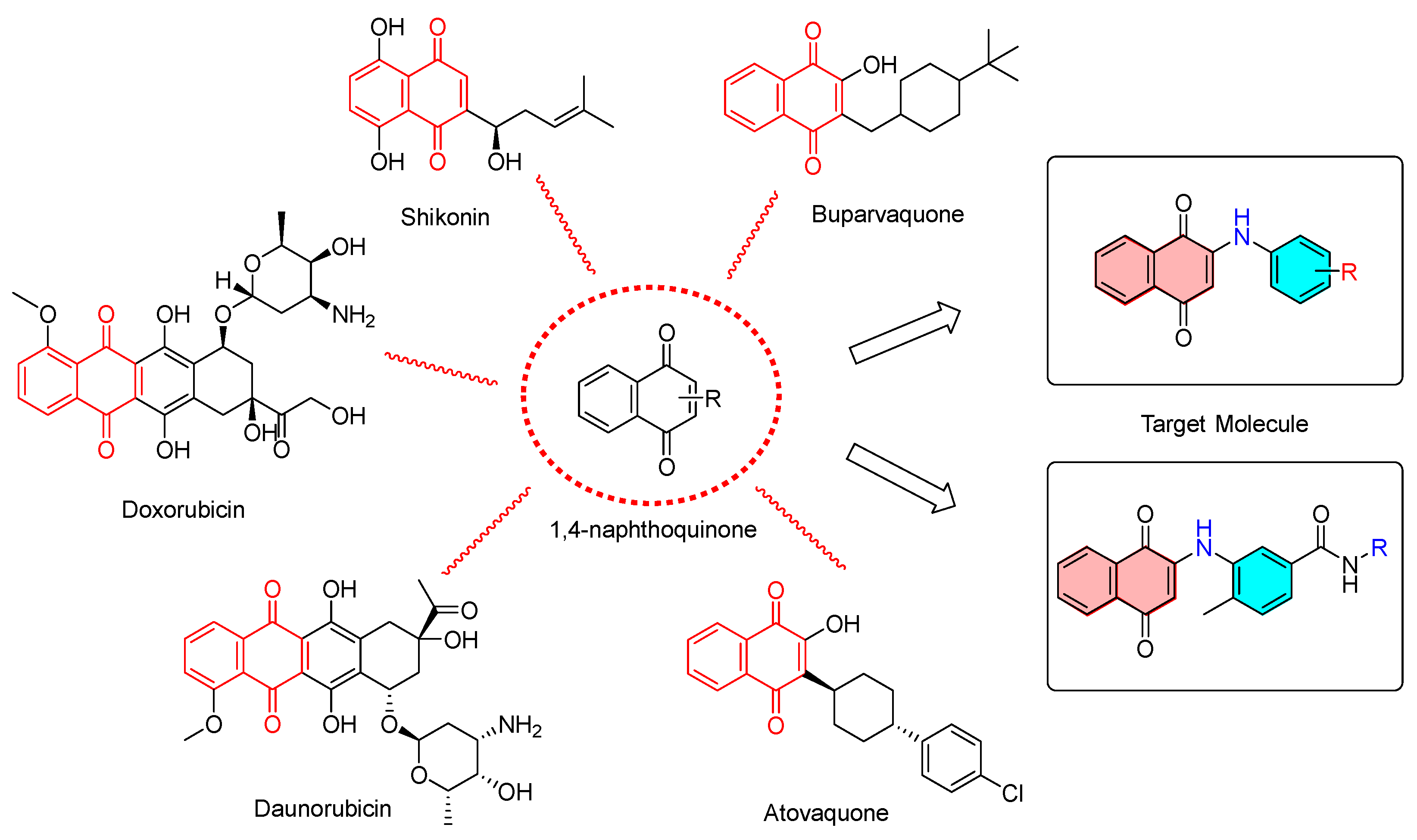
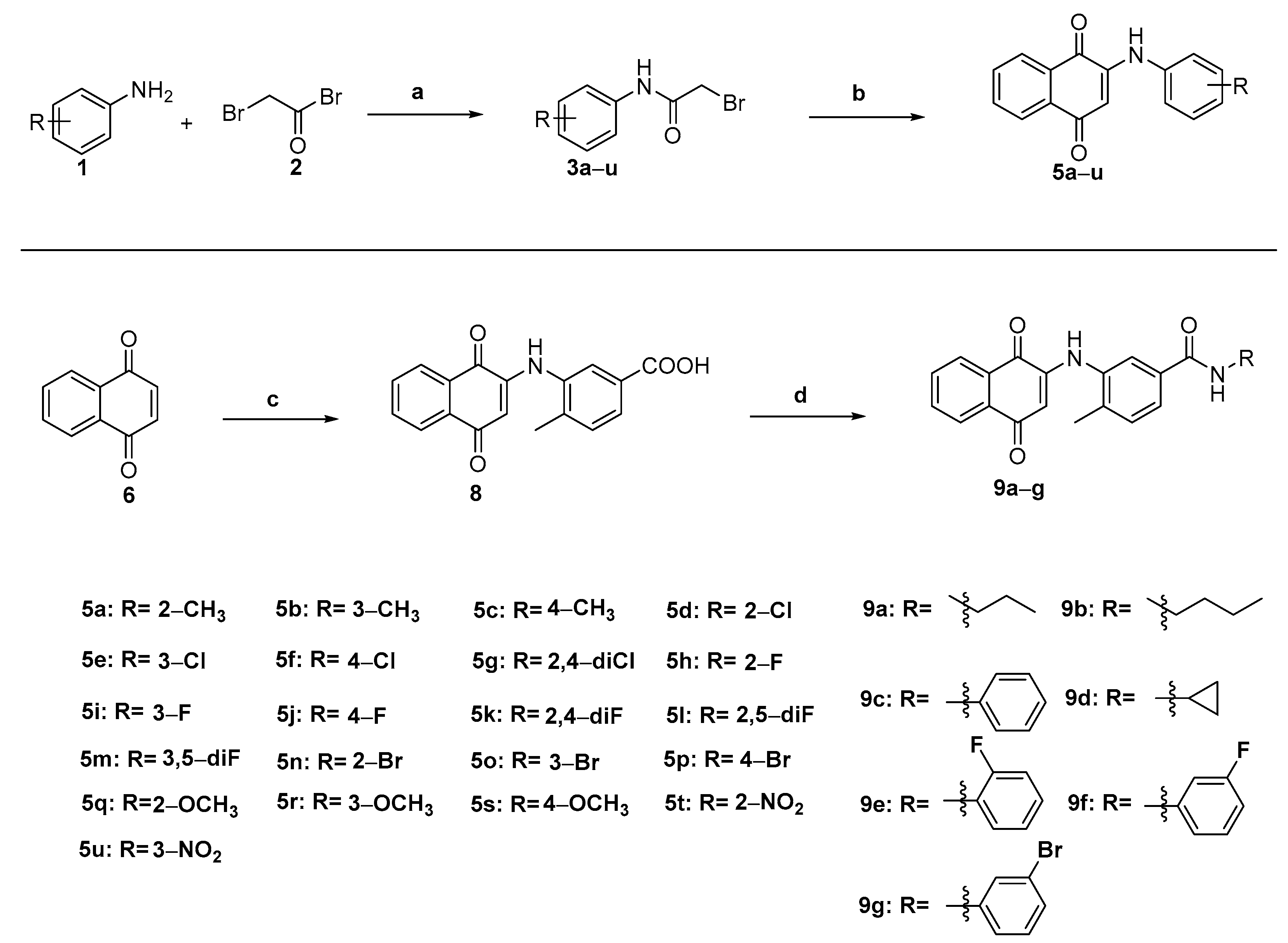
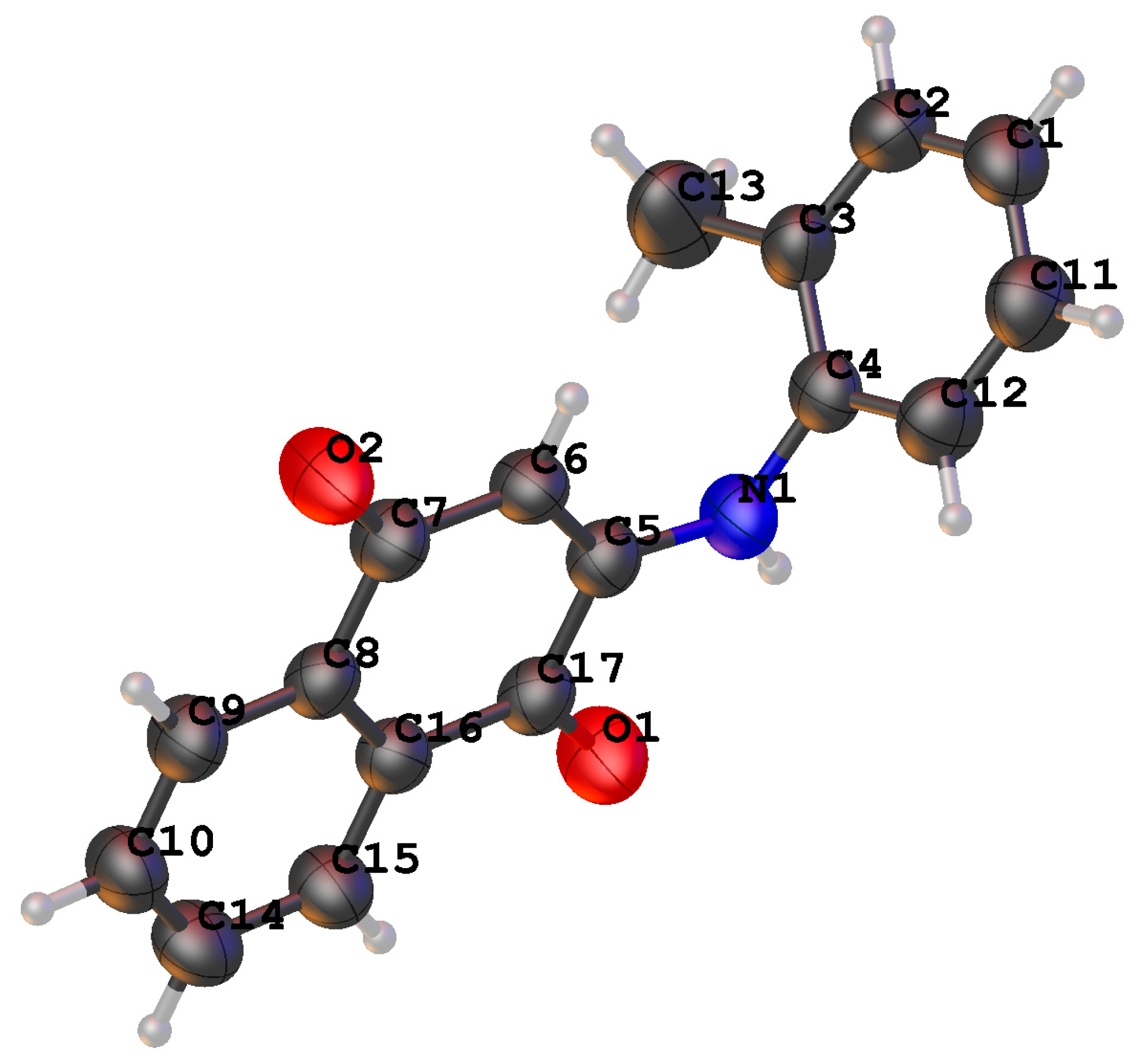

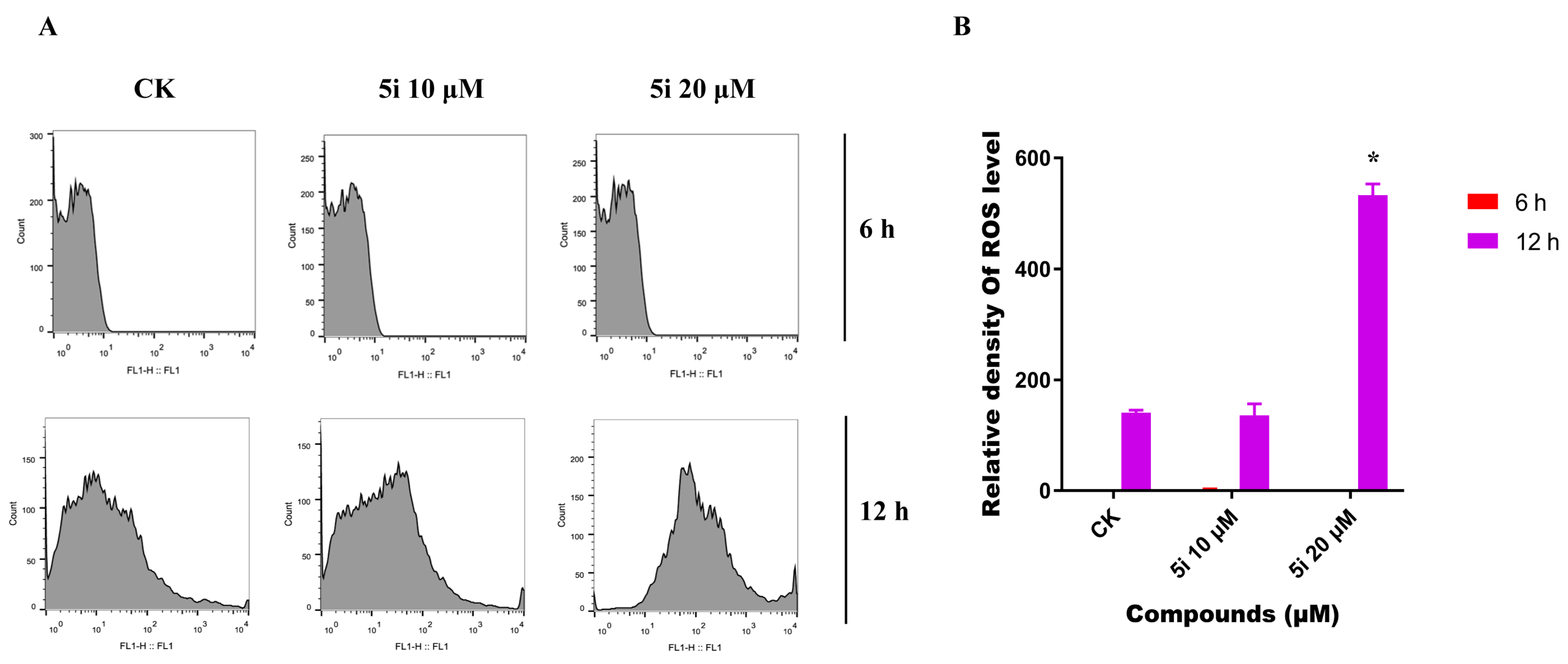
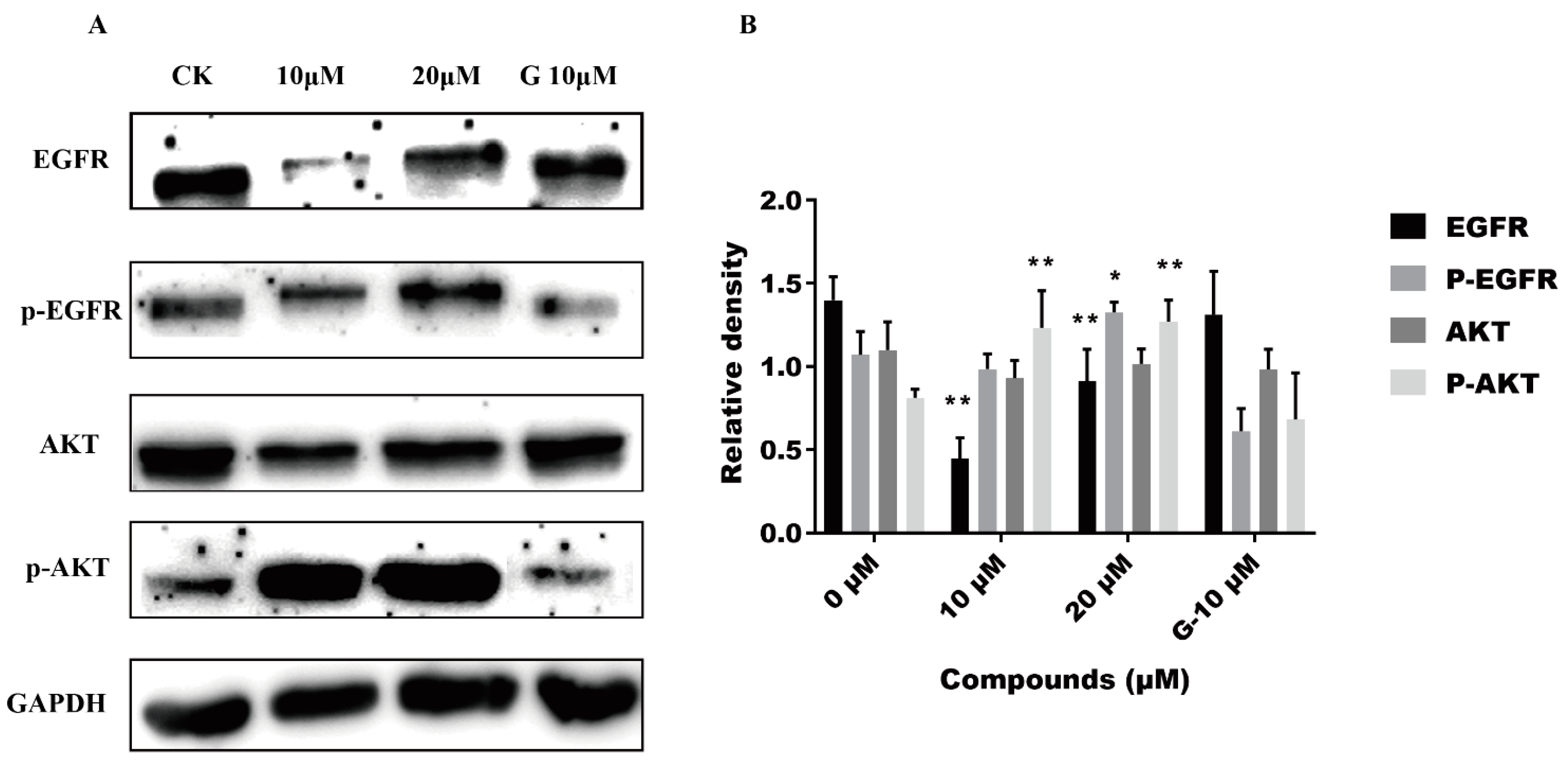
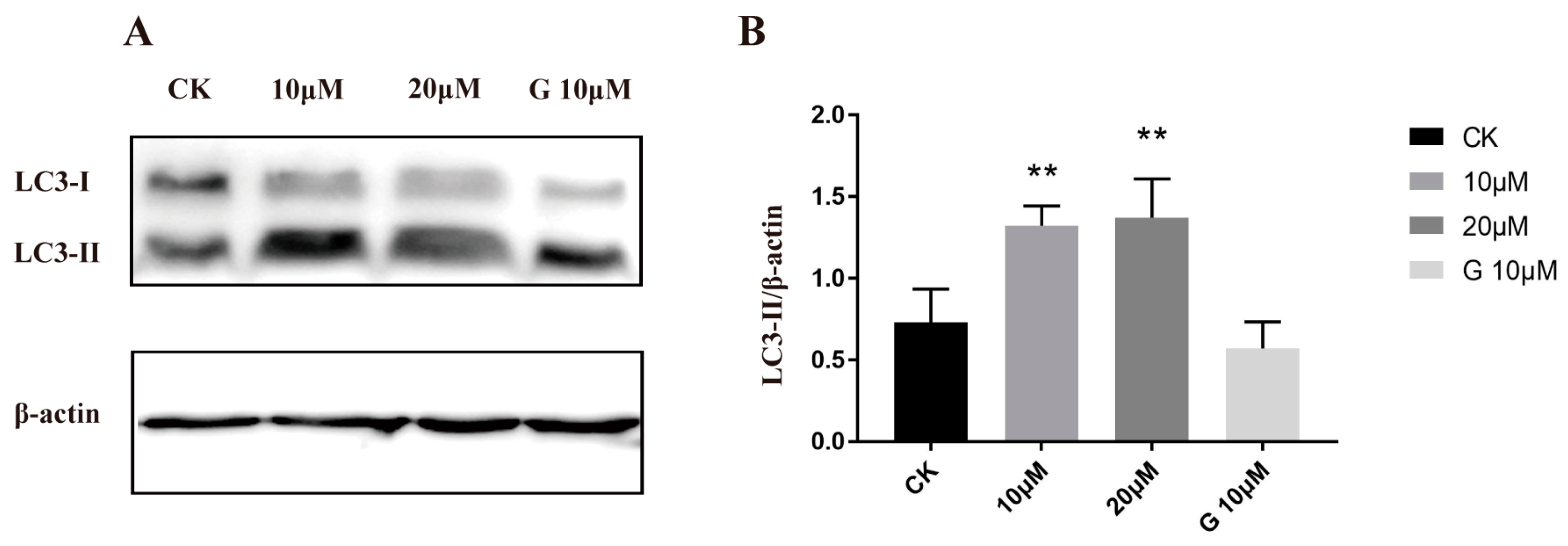
| Compounds | IC50 ± SD 1 (μM) | ||||
|---|---|---|---|---|---|
| R | A549 | K562 | HepG2 | PC-3 | |
| 5a | 2-CH3 | 8.59 ± 0.50 | - | - | - |
| 5b | 3-CH3 | 8.14 ± 0.34 | - | - | - |
| 5c | 4-CH3 | > 50 | - | - | - |
| 5d | 2-Cl | 20.32 ± 6.43 | - | - | - |
| 5e | 3-Cl | 23.45 ± 7.54 | - | - | 14.49 ± 1.38 |
| 5f | 4-Cl | > 50 | - | - | - |
| 5g | 2,4-diCl | 14.11 ± 1.68 | - | - | - |
| 5h | 2-F | 23.59 ± 7.21 | - | - | 34.61 ± 6.45 |
| 5i | 3-F | 6.15 ± 0.19 | - | - | - |
| 5j | 4-F | 19.03 ± 3.86 | 17.79 ± 3.21 | 26.42 ± 3.05 | 18.4 ± 3.46 |
| 5k | 2,4-diF | 17.23 ± 4.89 | - | 20.15 ± 2.49 | - |
| 5l | 2,5-diF | 7.99 ± 1.27 | - | 23.59 ± 5.27 | 23.78 ± 5.94 |
| 5m | 3,5-diF | 6.83 ± 0.72 | 25.61 ± 9.62 | - | - |
| 5n | 2-Br | 26.58 ± 8.98 | - | 23.64 ± 5.08 | 9.71 ± 1.87 |
| 5o | 3-Br | 21.23 ± 3.55 | 26.60 ± 6.18 | - | - |
| 5p | 4-Br | 8.34 ± 3.13 | 19.53 ± 7.86 | - | 10.31 ± 0.82 |
| 5q | 2-OCH3 | 10.44 ± 0.52 | - | - | - |
| 5r | 3-OCH3 | 27.76 ± 3.56 | - | - | - |
| 5s | 4-OCH3 | 16.77 ± 2.81 | 29.62 ± 8.90 | - | 19.34 ± 4.74 |
| 5t | 2-NO2 | 8.45 ± 2.15 | - | - | - |
| 5u | 3-NO2 | 15.64 ± 1.87 | - | - | - |
| 9a | propylamine | 20.32 ± 6.70 | - | - | - |
| 9b | butylamine | 22.00 ± 3.06 | 21.42 ± 4.02 | 17.90 ± 1.64 | - |
| 9c | phenyl | 35.55 ± 7.98 | - | - | - |
| 9d | cyclopropyl | 16.54 ± 3.83 | - | - | - |
| 9e | 2-fluorophenyl | 14.32 ± 4.18 | - | - | - |
| 9f | 3-fluorophenyl | 23.03 ± 4.81 | 24.07 ± 2.67 | - | - |
| 9g | 3-bromophenyl | 21.31 ± 6.59 | - | 22.36 ± 1.45 | 15.49 ± 1.55 |
| G 2 | 22.11 ± 2.32 | 15.64 ± 2.59 | 30.67 ± 11.30 | 12.02 ± 5.40 | |
| 5-Fu 3 | 1.34 ± 0.32 | 4.01 ± 0.21 | 12.05 ± 5.27 | 8.95 ± 0.87 | |
Disclaimer/Publisher’s Note: The statements, opinions and data contained in all publications are solely those of the individual author(s) and contributor(s) and not of MDPI and/or the editor(s). MDPI and/or the editor(s) disclaim responsibility for any injury to people or property resulting from any ideas, methods, instructions or products referred to in the content. |
© 2023 by the authors. Licensee MDPI, Basel, Switzerland. This article is an open access article distributed under the terms and conditions of the Creative Commons Attribution (CC BY) license (https://creativecommons.org/licenses/by/4.0/).
Share and Cite
Tan, H.-Y.; Liang, F.-M.; Zhang, W.-J.; Zhang, Y.; Cui, J.-H.; Dai, Y.-Y.; Qiu, X.-M.; Wang, W.-H.; Zhou, Y.; Chen, D.-P.; et al. Novel 2-Amino-1,4-Naphthoquinone Derivatives Induce A549 Cell Death through Autophagy. Molecules 2023, 28, 3289. https://doi.org/10.3390/molecules28083289
Tan H-Y, Liang F-M, Zhang W-J, Zhang Y, Cui J-H, Dai Y-Y, Qiu X-M, Wang W-H, Zhou Y, Chen D-P, et al. Novel 2-Amino-1,4-Naphthoquinone Derivatives Induce A549 Cell Death through Autophagy. Molecules. 2023; 28(8):3289. https://doi.org/10.3390/molecules28083289
Chicago/Turabian StyleTan, Hua-Yuan, Feng-Ming Liang, Wen-Jing Zhang, Yi Zhang, Jun-Hao Cui, Yu-Yu Dai, Xue-Mei Qiu, Wen-Hang Wang, Yue Zhou, Dan-Ping Chen, and et al. 2023. "Novel 2-Amino-1,4-Naphthoquinone Derivatives Induce A549 Cell Death through Autophagy" Molecules 28, no. 8: 3289. https://doi.org/10.3390/molecules28083289
APA StyleTan, H.-Y., Liang, F.-M., Zhang, W.-J., Zhang, Y., Cui, J.-H., Dai, Y.-Y., Qiu, X.-M., Wang, W.-H., Zhou, Y., Chen, D.-P., & Li, C.-P. (2023). Novel 2-Amino-1,4-Naphthoquinone Derivatives Induce A549 Cell Death through Autophagy. Molecules, 28(8), 3289. https://doi.org/10.3390/molecules28083289






